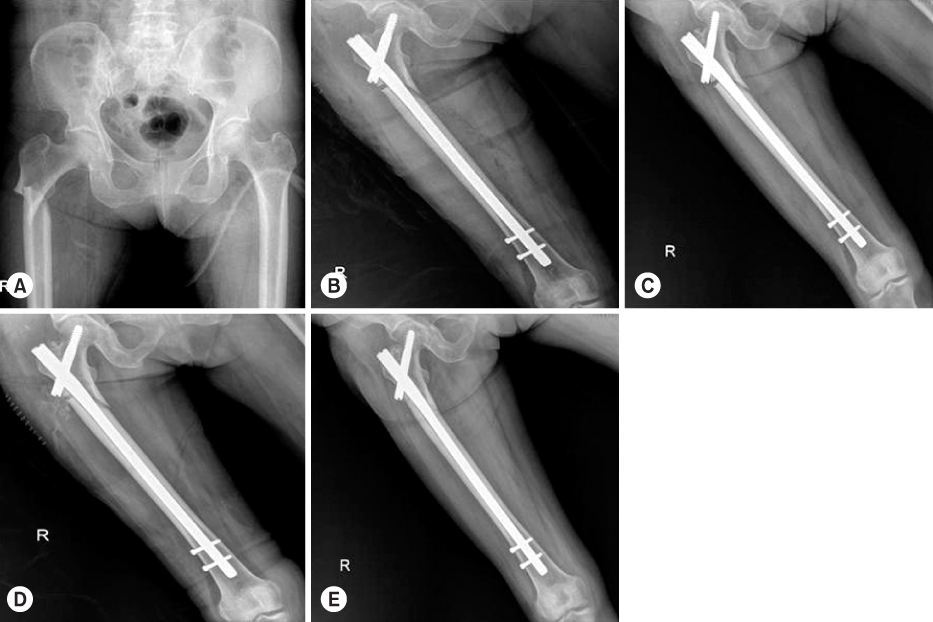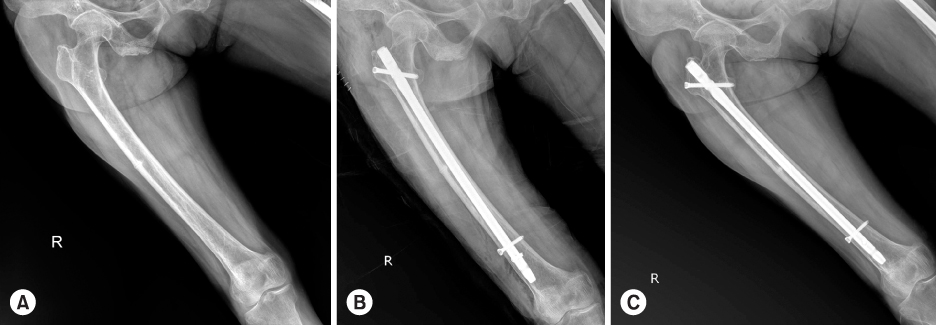J Korean Fract Soc.
2014 Jan;27(1):10-16. 10.12671/jkfs.2014.27.1.10.
Treatment and Prognosis of Femoral Insufficiency Fracture Associated with Prolonged Bisphosphonate Use
- Affiliations
-
- 1Department of Orthopedic Surgery, Busan Paik Hospital, Inje University College of Medicine, Busan, Korea. ronin211@naver.com
- KMID: 1816996
- DOI: http://doi.org/10.12671/jkfs.2014.27.1.10
Abstract
- PURPOSE
This study was conducted to investigate and identify an appropriate fracture treatment method by analyzing patients in whom a femoral incompetence fracture occurred after receiving a long-term bisphosphonate administration.
MATERIALS AND METHODS
The subjects of this study were 13 cases out of ten patients among those who had a history of receiving bisphosphonate for more than five years and had a fracture or an imminent fracture with a characteristic radiological finding in the femoral subtrochanteric region and the interfemoral region. The period of the drug administration, bone density, the existence of a prodromal symptom, and bilateral fracture were investigated.
RESULTS
In seven out of the 13 cases, the patients complained of painat the femoral and pelvic parts as a prodrome (53.8%), and three of them showed a bilateral fracture (30%). An imminent fracture with a prodrome was observed in six cases (46.2%); for three of these cases, a prophylactic fixture pexis was performed by inserting a metal nail into the medullary cavity, and in two out of these three, a complete fracture was found within 11 months on average (3 to 19 months). In the three prophylactic fixture pexis performed cases, no postoperative complications were found, and a radiological finding of concrescence was seen within one year after the operation. Among the nine operation performed cases after the fracture, non-union was found in two.
CONCLUSION
In the patients who have received bisphosphonate for a long periodof time, a prodome may be a useful indicator of a fracture in the femoral subtrochanteric region and the interfemoral region; therefore, a careful observation is necessary. A prophylactic internal fixation is recommended for patients with imminent fracture with a prodome since they have a high risk of a complete fracture is high in them.
MeSH Terms
Figure
Cited by 1 articles
-
Subtrochanteric Fracture Reduction during Intramedullary Nailing: Technical Note
Gyu Min Kong
J Korean Fract Soc. 2019;32(2):107-111. doi: 10.12671/jkfs.2019.32.2.107.
Reference
-
1. Arkan SSN, Bakir KK, Göran OS. Bisphosphonate-induced femoral fragility fractures: what do we know? Orthop Res Rev. 2010; 2:27–34.2. Banffy MB, Vrahas MS, Ready JE, Abraham JA. Nonoperative versus prophylactic treatment of bisphosphonate-associated femoral stress fractures. Clin Orthop Relat Res. 2011; 469:2028–2034.
Article3. Boivin G, Meunier PJ. Changes in bone remodeling rate influence the degree of mineralization of bone. Connect Tissue Res. 2002; 43:535–537.
Article4. Currey JD. Effects of differences in mineralization on the mechanical properties of bone. Philos Trans R Soc Lond B Biol Sci. 1984; 304:509–518.
Article5. Fowler JR, Craig MR. Association of low-energy femoral shaft fractures and bisphosphonate use. Orthopedics. 2012; 35:e38–e40.
Article6. Gates BJ, Sonnett TE, Duvall CA, Dobbins EK. Review of osteoporosis pharmacotherapy for geriatric patients. Am J Geriatr Pharmacother. 2009; 7:293–323.
Article7. Girgis CM, Sher D, Seibel MJ. Atypical femoral fractures and bisphosphonate use. N Engl J Med. 2010; 362:1848–1849.
Article8. Isaacs JD, Shidiak L, Harris IA, Szomor ZL. Femoral insufficiency fractures associated with prolonged bisphosphonate therapy. Clin Orthop Relat Res. 2010; 468:3384–3392.
Article9. Kwek EB, Goh SK, Koh JS, Png MA, Howe TS. An emerging pattern of subtrochanteric stress fractures: a long-term complication of alendronate therapy? Injury. 2008; 39:224–231.
Article10. Leslie WD, O'Donnell S, Jean S, et al. Osteoporosis Surveillance Expert Working Group. Trends in hip fracture rates in Canada. JAMA. 2009; 302:883–889.
Article11. Luckman SP, Hughes DE, Coxon FP, Graham R, Russell G, Rogers MJ. Nitrogen-containing bisphosphonates inhibit the mevalonate pathway and prevent post-translational prenylation of GTP-binding proteins, including Ras. J Bone Miner Res. 1998; 13:581–589.
Article12. Morris CD, Einhorn TA. Bisphosphonates in orthopaedic surgery. J Bone Joint Surg Am. 2005; 87:1609–1618.
Article13. Odvina CV, Zerwekh JE, Rao DS, Maalouf N, Gottschalk FA, Pak CY. Severely suppressed bone turnover: a potential complication of alendronate therapy. J Clin Endocrinol Metab. 2005; 90:1294–1301.
Article14. Park JG, Song KS, Jung HJ, Lee JS, Lee TJ, Kim KS. Bilateral femoral subtrochanteric insufficiency fractures after long-term bisphosphonate therapy. J Korean Orthop Assoc. 2010; 45:146–150.
Article15. Puah KL, Tan MH. Bisphosphonate-associated atypical fracture of the femur: spontaneous healing with drug holiday and re-appearance after resumed drug therapy with bilateral simultaneous displaced fractures--a case report. Acta Orthop. 2011; 82:380–382.
Article16. Rodan GA, Reszka AA. Osteoporosis and bisphosphonates. J Bone Joint Surg Am. 2003; 85:Suppl 3. 8–12.
Article17. Russell RG, Watts NB, Ebetino FH, Rogers MJ. Mechanisms of action of bisphosphonates: similarities and differences and their potential influence on clinical efficacy. Osteoporos Int. 2008; 19:733–759.
Article18. Shane E, Burr D, Ebeling PR, et al. Atypical subtrochanteric and diaphyseal femoral fractures: report of a task force of the American Society for Bone and Mineral Research. J Bone Miner Res. 2010; 25:2267–2294.
Article19. Wasserman N, Yerramshetty J, Akkus O. Microcracks colocalize within highly mineralized regions of cortical bone tissue. Eur J Morphol. 2005; 42:43–51.
Article
- Full Text Links
- Actions
-
Cited
- CITED
-
- Close
- Share
- Similar articles
-
- Insufficiency Fracture of Simultaneously Bilateral Femur Neck in Patient Treated with Long-Term Bisphosphonate Treatment - A Case Report -
- Sequential Bilateral Insufficiency Fractures of the Femur Neck in Patients Treated with Prolonged Bisphosphonate Therapy: A Case Report
- Insufficiency Fracture of Ipsilateral Femur Neck in Patient Treated with Long Term Bisphosphonate Treatment: A Case Report
- Is It a Simple Stress Fracture or Bisphosphonate-related Atypical Fracture?
- Atypical Fracture-Like Insufficiency Fracture of the Tibia with Prolonged Bisphosphonate Drug: A Case Report




